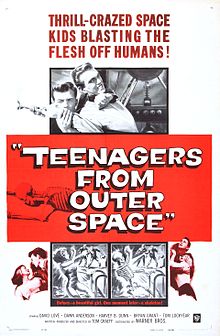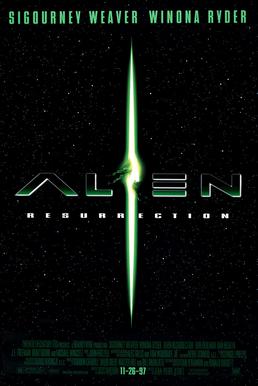
Alien Resurrection is a 1997 American science fiction horror film, directed by Jean-Pierre Jeunet, written by Joss Whedon, and starring Sigourney Weaver and Winona Ryder. It is the fourth installment of the Alien franchise, and was filmed at the 20th Century Fox studios in Los Angeles, California.
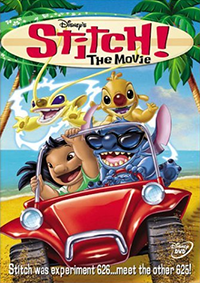
Stitch! The Movie is a 2003 American direct-to-video animated science fiction comedy film produced by Walt Disney Television Animation and Rough Draft Korea, released on August 26, 2003. It is produced by Tony Craig, Jess Winfield, and Roberts "Bobs" Gannaway; Gannaway also co-wrote and co-directed with Winfield and Craig, respectively. It is the second film released in the Lilo & Stitch franchise and the third film chronologically, taking place after the 2002 first film and the 2005 direct-to-video sequel Lilo & Stitch 2: Stitch Has a Glitch. The film also serves as the backdoor pilot of the spin-off sequel series Lilo & Stitch: The Series, which Craig, Winfield, and Gannaway executive produced and debuted the following month. The story is an introduction to Dr. Jumba Jookiba's 625 experiments that he created with the financing of Dr. Jacques von Hämsterviel.

It! The Terror from Beyond Space is an independently made 1958 American science fiction horror film, produced by Robert Kent, directed by Edward L. Cahn, that stars Marshall Thompson, Shawn Smith, and Kim Spalding. The film was distributed by United Artists as a double feature with Curse of the Faceless Man.

Gamera vs. Guiron is a 1969 Japanese kaiju film directed by Noriaki Yuasa, written by Niisan Takahashi, and produced by Daiei Film. It is the fifth entry in the Gamera film series, following Gamera vs. Viras, which was released the previous year. Gamera vs. Guiron stars Nobuhiro Kajima, Miyuki Akiyama, Christopher Murphy, Yuko Hamada, and Eiji Funakoshi. The film was released theatrically in Japan on March 21, 1969. It did not receive a theatrical release in the United States, but was released directly to American television that year by American International Television under the title Attack of the Monsters. The film was followed by Gamera vs. Jiger the following year.
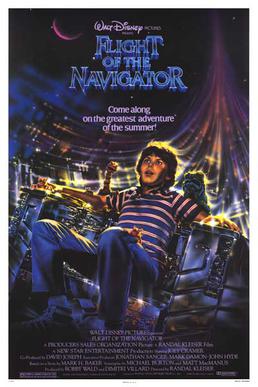
Flight of the Navigator is a 1986 American science-fiction adventure film directed by Randal Kleiser and written by Mark H. Baker, Michael Burton, and Matt MacManus. It stars Joey Cramer as David Freeman, a 12-year-old boy, who is abducted by an alien spaceship and transported from 1978 to 1986. It features an early film appearance by Sarah Jessica Parker as Carolyn McAdams, a key character who befriends David in a time of need.

It Came from Outer Space is a 1953 American science fiction horror film, the first in the 3D process from Universal-International. It was produced by William Alland and directed by Jack Arnold. The film stars Richard Carlson and Barbara Rush, and features Charles Drake, Joe Sawyer, and Russell Johnson. The script is based on Ray Bradbury's original film treatment "The Meteor" and not, as sometimes claimed, a published short story.

It Came from Hollywood is a 1982 American comedy documentary film compiling clips from various B movies. Written by Dana Olsen and directed by Malcolm Leo and Andrew Solt, the film features wraparound segments and narration by several famous comedians, including Dan Aykroyd, John Candy, Gilda Radner, and Cheech and Chong. Sections of It Came from Hollywood focus on gorilla pictures, anti-marijuana films and the works of Ed Wood. The closing signature song was the doo wop hit "What's Your Name" by Don and Juan.

I Married a Monster from Outer Space is a 1958 American horror science fiction film from Paramount Pictures, produced and directed by Gene Fowler Jr., that stars Tom Tryon and Gloria Talbott. Paramount released the film as a double feature with The Blob.

Commando Cody: Sky Marshal of the Universe is a 1953 twelve-chapter movie serial from Republic Pictures, which began life as a proposed syndicated television series. It consists of twelve 25-minute sequential episodes directed by Harry Keller, Franklin Adreon, and Fred C. Brannon. It stars Judd Holdren, Aline Towne, Gregory Gaye, William Schallert, Richard Crane, and Craig Kelly.

Many works of fiction have featured UFOs. In most cases, as the fictional story progresses, the Earth is being invaded by hostile alien forces from outer space, usually from Mars, as depicted in early science fiction, or the people are being destroyed by alien forces, as depicted in the film Independence Day. Some fictional UFO encounters may be based on real UFO reports, such as Night Skies. Night Skies is based on the 1997 Phoenix UFO Incident.

Thomas Lockyear Graeff was an American actor, film director, producer, screenwriter, film editor and cinematographer. He is best known for writing, directing, producing and starring in the 1959 B-movie Teenagers from Outer Space.
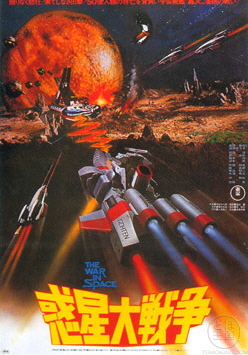
The War in Space, released in Japan as Great Planet War, is a tokusatsu science fiction film produced and released by Toho Studios in 1977.

Space-Men is a 1960 Italian science fiction film directed by Antonio Margheriti. The film stars Rik Van Nutter and co-stars Gabriella Farinon, David Montresor, Archie Savage, and Alain Dijon. The film was released in the United States in 1961 by American International Pictures.
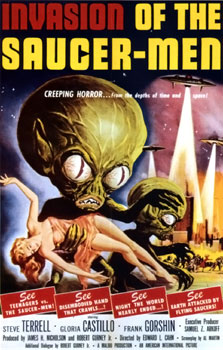
Invasion of the Saucer Men, is a 1957 black-and-white comic science fiction/comedy horror film produced by James H. Nicholson for release by American International Pictures. The film was directed by Edward L. Cahn and stars Stephen Terrell, Gloria Castillo, Raymond Hatton and Frank Gorshin.

Dawn Bender is an American film, stage, and radio actress, most famous for the role of Margaret on the radio drama One Man's Family and Betty Morgan in Teenagers from Outer Space.
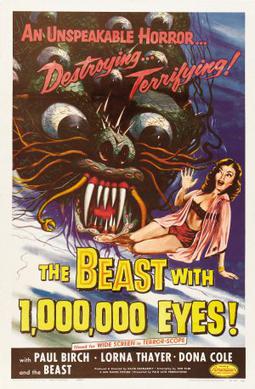
The Beast with a Million Eyes is a 1955 independently made American black-and-white science fiction film, produced and directed by David Kramarsky, that stars Paul Birch, Lorna Thayer, and Dona Cole. Some film sources have said that the film was co-directed by Lou Place. The film was co-produced by Roger Corman and Samuel Z. Arkoff. and was released by American Releasing Corporation, which later became American International Pictures.
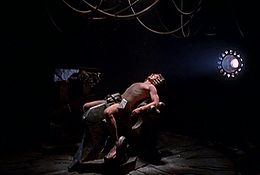
"Without" is the second episode of the eighth season of the science fiction television series The X-Files. The episode first aired in the United States and Canada on November 12, 2000, on Fox and subsequently aired in the United Kingdom on February 18, 2001. It was written by executive producer Chris Carter and directed by Kim Manners. The episode helps to explore the series' overarching mythology and continues from the seventh season finale, "Requiem", and season eight premiere, "Within", in which Fox Mulder was abducted by aliens who are planning to colonize Earth. The episode earned a Nielsen rating of 9.0 in the United States and was seen by 15.1 million viewers. As with the previous episode, "Within," it was generally well-received by critics, although some detractors criticized various plot points.
Space Probe Taurus is a 1965 low budget black-and-white science fiction/action/drama film from American International Pictures, written and directed by Leonard Katzman, and starring Francine York, James E. Brown, Baynes Barrow, and Russ Bender.

Invisible Invaders is a 1959 American science fiction film starring John Agar, Jean Byron, John Carradine and Philip Tonge. It was produced by Robert E. Kent, directed by Edward L. Cahn and written by Samuel Newman.

Paul Blaisdell was an American painter, sculptor and visual effects creator, best remembered for his work in science fiction and horror B movies of the 1950s.
